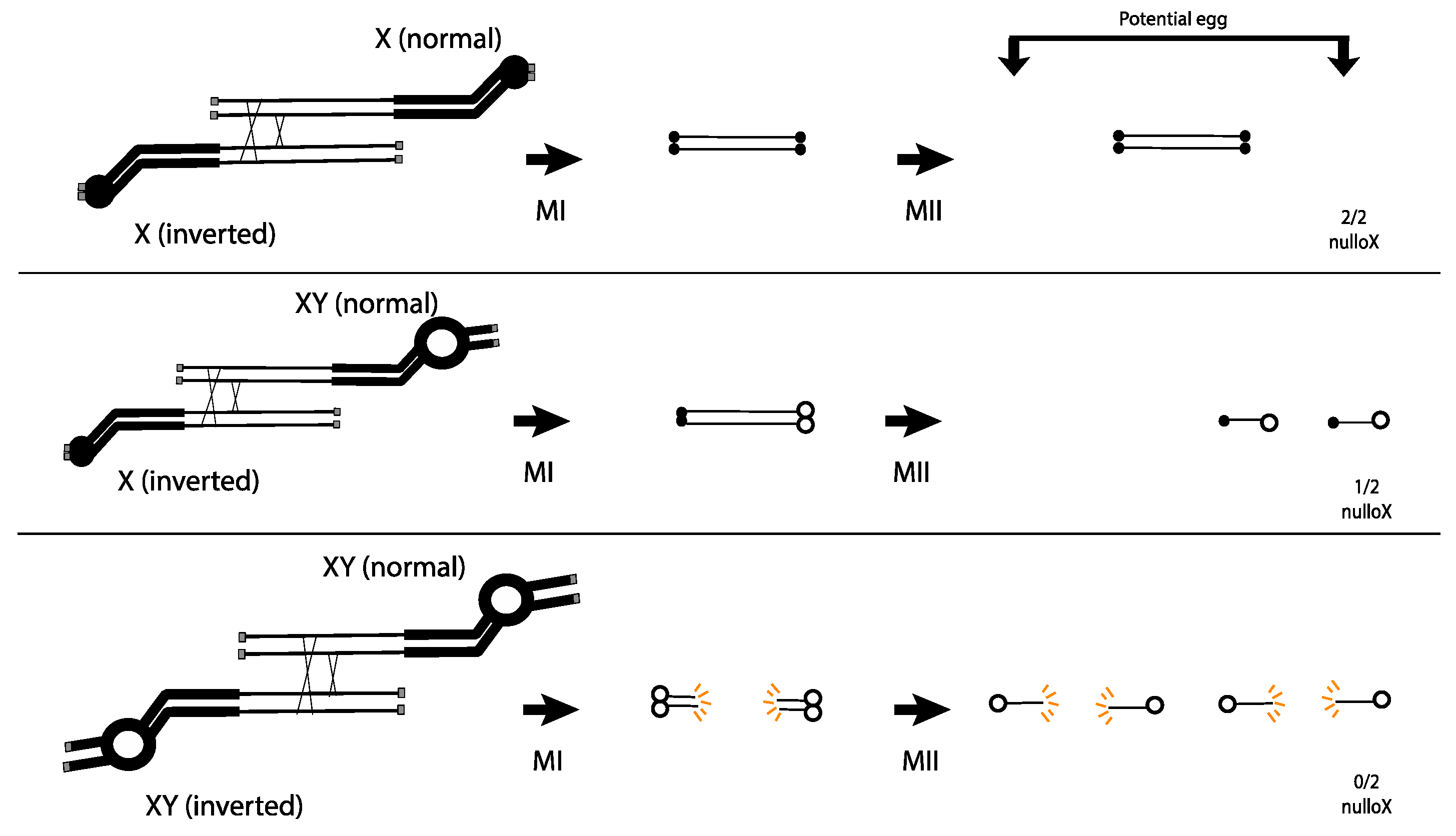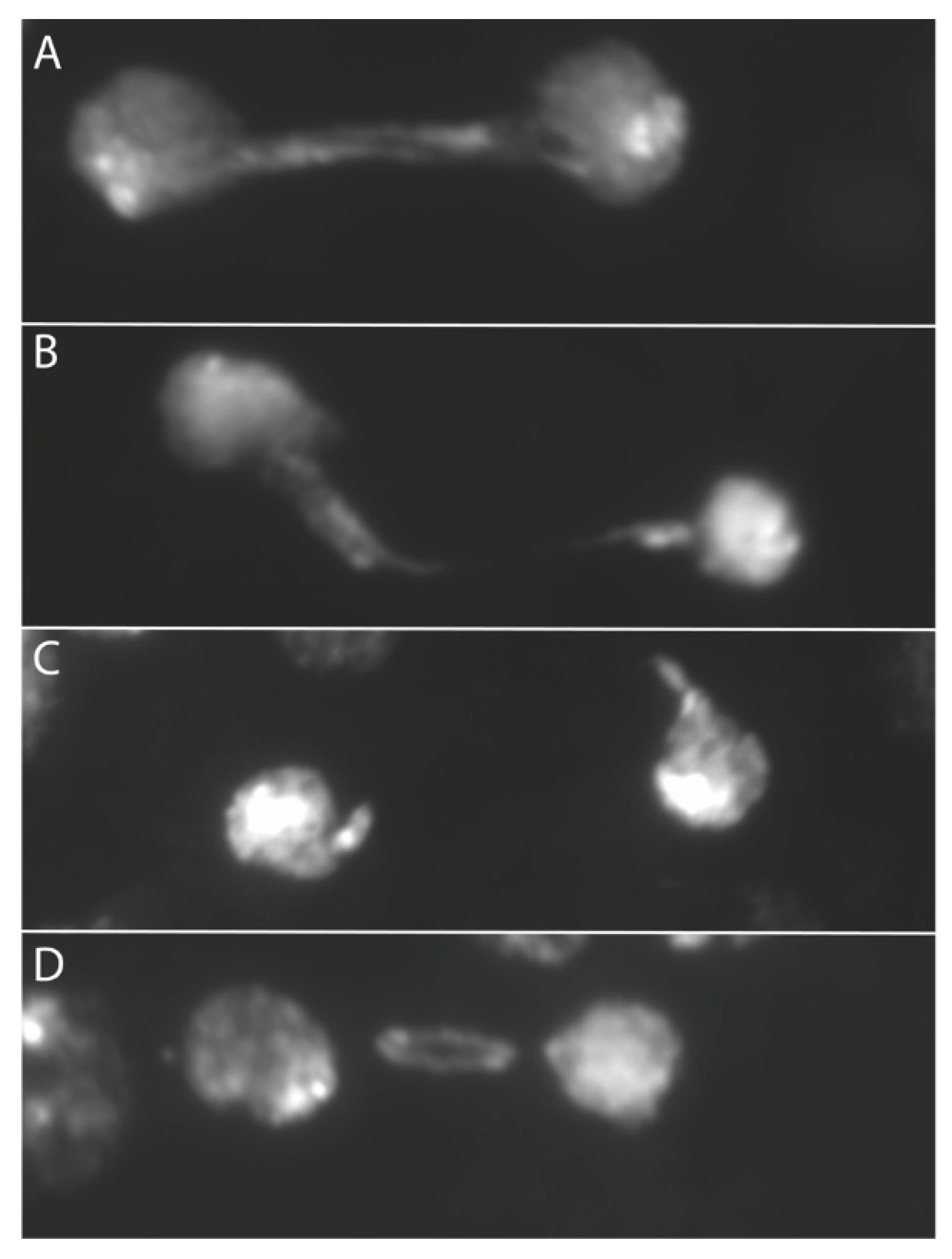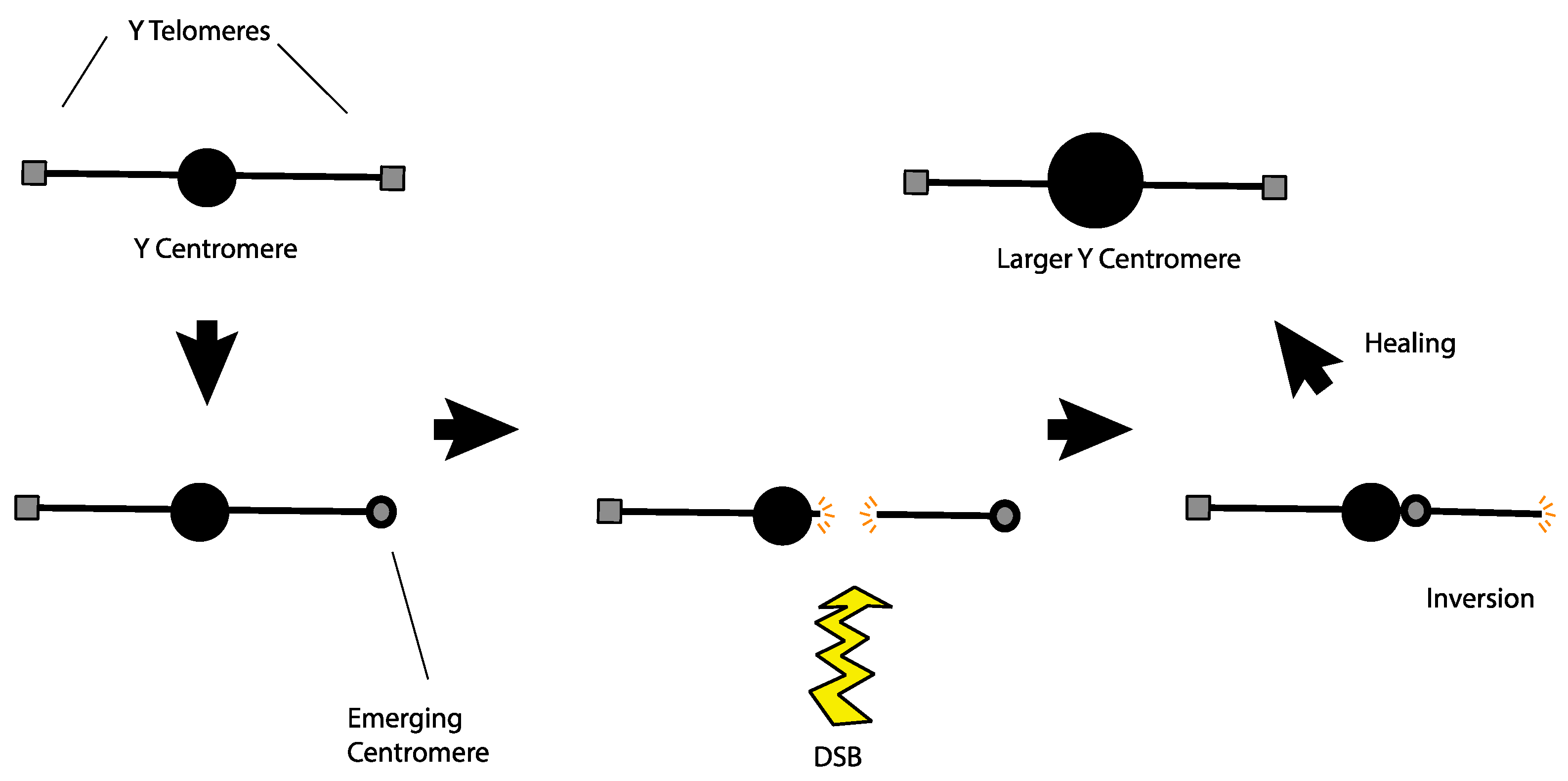Chromosome Tug of War: Dicentric Chromosomes and the Centromere Strength Hypothesis
Abstract
1. Introduction
2. Origins: The Centromere Strength Hypothesis
3. Chromosome vs. Spindle: How Does a Dicentric Break?
4. Strong and Weak Centromeres
5. Reconsidering Novitski
6. How Did the Y Obtain a Large Centromere?
7. Conclusions
Author Contributions
Funding
Institutional Review Board Statement
Informed Consent Statement
Data Availability Statement
Acknowledgments
Conflicts of Interest
References
- Nicklas, R.B. Chromosome Velocity During Mitosis as a Function of Chromosome Size and Position. J. Cell Biol. 1965, 25, 119–135. [Google Scholar] [CrossRef]
- Marshall, W.F.; Marko, J.F.; Agard, D.A.; Sedat, J.W. Chromosome Elasticity and Mitotic Polar Ejection Force Measured in Living Drosophila Embryos by Four-Dimensional Microscopy-Based Motion Analysis. Curr. Biol. 2001, 11, 569–578. [Google Scholar] [CrossRef]
- Ferraro-Gideon, J.; Sheykhani, R.; Zhu, Q.; Duquette, M.L.; Berns, M.W.; Forer, A. Measurements of Forces Produced by the Mitotic Spindle Using Optical Tweezers. Mol. Biol. Cell 2013, 24, 1375–1386. [Google Scholar] [CrossRef]
- Chacón, J.M.; Mukherjee, S.; Schuster, B.M.; Clarke, D.J.; Gardner, M.K. Pericentromere Tension Is Self-Regulated by Spindle Structure in Metaphase. J. Cell Biol. 2014, 205, 313–324. [Google Scholar] [CrossRef]
- Grishchuk, E.L.; Molodtsov, M.I.; Ataullakhanov, F.I.; Mcintosh, J.R. Force Production by Disassembling Microtubules. Nature 2005, 438, 384–388. [Google Scholar] [CrossRef]
- Sears, E.R.; Câmara, A. A Transmissible Dicentric Chromosome. Genetics 1952, 37, 125–135. [Google Scholar] [CrossRef]
- Novitski, E. Genetic Consequences of Anaphase Bridge Formation in Drosophila. Genetics 1952, 37, 270–287. [Google Scholar] [CrossRef]
- Sturtevant, A.H.; Beadle, G.W. The Relations of Inversions in the X Chromosome of Drosophila Melanogaster to Crossing over and Disjunction. Genetics 1936, 21, 554–604. [Google Scholar] [CrossRef]
- Hawley, R.S.; Ganetzky, B. Alfred Sturtevant and George Beadle Untangle Inversions. Genetics 2016, 203, 1001–1003. [Google Scholar] [CrossRef][Green Version]
- Beadle, G.W.; Sturtevant, A.H. X Chromosome Inversions and Meiosis in Drosophila Melanogaster. Proc. Natl. Acad. Sci. USA 1935, 21, 384–390. [Google Scholar] [CrossRef]
- Robbins, L.G. Exchange within Heterozygous Inversions in Drosophila Melanogaster. Genetics 1974, 77, 105–114. [Google Scholar] [CrossRef]
- Hinton, C.W.; Lucchesi, J.C. A Cytogenetic Study of Crossing over in Inversion Heterozygotes of Drosophila Melanogaster. Genetics 1960, 45, 87–94. [Google Scholar] [CrossRef]
- McClintock, B. The Behavior in Successive Nuclear Divisions of a Chromosome Broken at Meiosis. Genetics 1939, 25, 405–416. [Google Scholar] [CrossRef]
- McClintock, B. The Stability of Broken Ends of Chromosomes in Zea Mays. Genetics 1941, 26, 234–282. [Google Scholar] [CrossRef]
- McClintock, B. Maize Genetics. Year B Carnegie Inst. Wash. 1946, 45, 176–186. [Google Scholar]
- McClintock, B. The Production of Homozygous Deficient Tissues with Mutant Characteristics by Means of the Aberrant Mitotic Behavior of Ring-Shaped Chromosomes. Genetics 1938, 23, 315–376. [Google Scholar] [CrossRef]
- Lopez, V.; Barinova, N.; Onishi, M.; Pobiega, S.; Pringle, J.R.; Dubrana, K. Cytokinesis Breaks Dicentric Chromosomes Preferentially at Pericentromeric Regions and Telomere Fusions. Genes Dev. 2015, 29, 322–336. [Google Scholar] [CrossRef]
- Maciejowski, J.; Li, Y.; Bosco, N.; Campbell, P.J.; De Lange, T. Chromothripsis and Kataegis Induced by Telomere Crisis. Cell 2015, 163, 1641–1654. [Google Scholar] [CrossRef]
- Guérin, T.M.; Marcand, S. Breakage in Breakage–Fusion–Bridge Cycle: An 80-Year-Old Mystery. Trends Genet. 2022, 38, 641–645. [Google Scholar] [CrossRef]
- Grandbois, M.; Beyer, M.; Rief, M.; Clausen-Schaumann, H.; Gaub, H.E. How Strong Is a Covalent Bond? Science 1999, 283, 1727–1731. [Google Scholar] [CrossRef]
- Levinthal, C.; Davison, P.F. Degradation of Deoxyribonucleic Acid under Hydrodynamic Shearing Forces. J. Mol. Biol. 1961, 3, 674–683. [Google Scholar] [CrossRef]
- Harrington, R.E.; Zimm, B.H. Degradation of Polymers by Controlled Hydrodynamic Shear. J. Phys. Chem. 1965, 69, 161–175. [Google Scholar] [CrossRef]
- Bensimon, D.; Croquette, V.; Bensimon, A. Stretching DNA with a Receding Meniscus: Experiments and Models. Phys. Rev. Lett. 1995, 74, 4754–4757. [Google Scholar] [CrossRef] [PubMed]
- Fong, K.K.; Sarangapani, K.K.; Yusko, E.C.; Riffle, M.; Llauró, A.; Graczyk, B.; Davis, T.N.; Asbury, C.L. Direct Measurement of the Strength of Microtubule Attachment to Yeast Centrosomes. Mol. Biol. Cell 2017, 28, 1853–1861. [Google Scholar] [CrossRef]
- Hughes, S.E.; Miller, D.E.; Miller, A.L.; Hawley, R.S. Female Meiosis: Synapsis, Recombination, and Segregation in Drosophila Melanogaster. Genetics 2018, 208, 875–908. [Google Scholar] [CrossRef]
- Endow, S.A.; Marszalek, P.E. An Estimate to the First Approximation of Microtubule Rupture Force. Eur. Biophys. J. 2019, 48, 569–577. [Google Scholar] [CrossRef]
- Akiyoshi, B.; Sarangapani, K.K.; Powers, A.F.; Nelson, C.R.; Reichow, S.L.; Arellano-Santoyo, H.; Gonen, T.; Ranish, J.A.; Asbury, C.L.; Biggins, S. Tension Directly Stabilizes Reconstituted Kinetochore-Microtubule Attachments. Nature 2010, 468, 576–579. [Google Scholar] [CrossRef]
- Ye, A.A.; Cane, S.; Maresca, T.J. Chromosome Biorientation Produces Hundreds of Piconewtons at a Metazoan Kinetochore. Nat. Commun. 2016, 7, 13221. [Google Scholar] [CrossRef]
- Talbert, P.B.; Henikoff, S. What Makes a Centromere? Exp. Cell Res. 2020, 389, 111895. [Google Scholar] [CrossRef]
- Lin, H.P.; Ault, J.G.; Church, K. Meiosis in Drosophila Melanogaster. Chromosoma 1981, 83, 507–521. [Google Scholar] [CrossRef]
- McEwen, B.F.; Chan, G.K.T.; Zubrowski, B.; Savoian, M.S.; Sauer, M.T.; Yen, T.J. CENP-E Is Essential for Reliable Bioriented Spindle Attachment, but Chromosome Alignment Can Be Achieved via Redundant Mechanisms in Mammalian Cells. Mol. Biol. Cell 2001, 12, 2776–2789. [Google Scholar] [CrossRef] [PubMed]
- Fuge, H. Ultrastructure and Function of the Spindle Apparatus. Microtubules and Chromosomes during Nuclear Division. Protoplasma 1974, 82, 289–320. [Google Scholar] [CrossRef] [PubMed]
- Strunov, A.; Boldyreva, L.V.; Andreyeva, E.N.; Pavlova, G.A.; Popova, J.V. Ultrastructural Analysis of Mitotic Drosophila S2 Cells Identifies Distinctive Microtubule and Intracellular Membrane Behaviors. BMC Biol. 2018, 16, 68. [Google Scholar] [CrossRef] [PubMed]
- Maiato, H.; Hergert, P.J.; Mcewen, B.F. The Ultrastructure of the Kinetochore and Kinetochore Fiber in Drosophila Somatic. Cells 2006, 115, 469–480. [Google Scholar] [CrossRef]
- Hays, T.S.; Salmon, E.D. Poleward Force at the Kinetochore in Metaphase Depends on the Number of Kinetochore Microtubules. J. Cell Biol. 1990, 110, 391–404. [Google Scholar] [CrossRef]
- Nicklas, R.B. Measurements of the Force Produced by the Mitotic Spindle in Anaphase. J. Cell Biol. 1983, 97, 542–548. [Google Scholar] [CrossRef]
- Ohzeki, J.I.; Bergmann, J.H.; Kouprina, N.; Noskov, V.N.; Nakano, M.; Kimura, H.; Earnshaw, W.C.; Larionov, V.; Masumoto, H. Breaking the HAC Barrier: Histone H3K9 Acetyl/Methyl Balance Regulates CENP-A Assembly. EMBO J. 2012, 31, 2391–2402. [Google Scholar] [CrossRef]
- Mendiburo, M.J.; Padeken, J.; Fülöp, S.; Schepers, A.; Heun, P. Drosophila CENH3 Is Sufficient for Centromere Formation. Science 2011, 334, 686–690. [Google Scholar] [CrossRef]
- Logsdon, G.A.; Barrey, E.J.; Bassett, E.A.; DeNizio, J.E.; Guo, L.Y.; Panchenko, T.; Dawicki-McKenna, J.M.; Heun, P.; Black, B.E. Both Tails and the Centromere Targeting Domain of CENP-A Are Required for Centromere Establishment. J. Cell Biol. 2015, 208, 521–531. [Google Scholar] [CrossRef]
- Hori, T.; Shang, W.H.; Takeuchi, K.; Fukagawa, T. The CCAN Recruits CENP-A to the Centromere and Forms the Structural Core for Kinetochore Assembly. J. Cell Biol. 2013, 200, 45–60. [Google Scholar] [CrossRef]
- Barnhart, M.C.; Kuich, P.H.J.L.; Stellfox, M.E.; Ward, J.A.; Bassett, E.A.; Black, B.E.; Foltz, D.R. HJURP Is a CENP-A Chromatin Assembly Factor Sufficient to Form a Functional de Novo Kinetochore. J. Cell Biol. 2011, 194, 229–243. [Google Scholar] [CrossRef] [PubMed]
- Tachiwana, H.; Müller, S.; Blümer, J.; Klare, K.; Musacchio, A.; Almouzni, G. HJURP Involvement in de Novo CenH3CENP-A and CENP-C Recruitment. Cell Rep. 2015, 11, 22–32. [Google Scholar] [CrossRef] [PubMed]
- Palladino, J.; Chavan, A.; Sposato, A.; Madon, T.D.; Mellone, B.G. Targeted de Novo Centromere Formation in Drosophila Reveals Plasticity and Mantenance Potential of Cenp-A Chromatin. Dev. Cell 2020, 52, 379–394. [Google Scholar] [CrossRef] [PubMed]
- Heun, P.; Erhardt, S.; Blower, M.D.; Weiss, S.; Skora, A.D.; Karpen, G.H. Mislocalization of the Drosophila Centromere-Specific Histone CID Promotes Formation of Functional Ectopic Kinetochores. Dev. Cell 2006, 10, 303–315. [Google Scholar] [CrossRef]
- Olszak, A.M.; Van Essen, D.; Pereira, A.J.; Diehl, S.; Manke, T.; Maiato, H.; Saccani, S.; Heun, P. Heterochromatin Boundaries Are Hotspots for de Novo Kinetochore Formation. Nat. Cell Biol. 2011, 13, 799–808. [Google Scholar] [CrossRef] [PubMed]
- Raychaudhuri, N.; Dubruille, R.; Orsi, G.A.; Bagheri, H.C.; Loppin, B.; Lehner, C.F. Transgenerational Propagation and Quantitative Maintenance of Paternal Centromeres Depends on Cid/Cenp-A Presence in Drosophila Sperm. PLoS Biol. 2012, 10, 1–19. [Google Scholar] [CrossRef]
- Chmátal, L.; Gabriel, S.I.; Mitsainas, G.P.; Martínez-Vargas, J.; Ventura, J.; Searle, J.B.; Schultz, R.M.; Lampson, M.A. Centromere Strength Provides the Cell Biological Basis for Meiotic Drive and Karyotype Evolution in Mice. Curr. Biol. 2014, 24, 2295–2300. [Google Scholar] [CrossRef]
- Akera, T.; Chmátal, L.; Trimm, E.; Yang, K.; Aonbangkhen, C.; Chenoweth, D.M.; Janke, C.; Schultz, R.M.; Lampson, M.A. Drive, Meiotic Mendelian Chromosome Segregation. Science 2017, 358, 1–6. [Google Scholar] [CrossRef]
- Henikoff, S.; Ahmad, K.; Malik, H.S. The Centromere Paradox: Stable Inheritance with Rapidly Evolving DNA. Science 2001, 293, 1098–1102. [Google Scholar] [CrossRef]
- Ahmad, K.; Golic, K.G. The Transmission of Fragmented Chromosomes in Drosophila Melanogaster. Genetics 1998, 148, 775–792. [Google Scholar] [CrossRef]
- Titen, S.W.A.; Golic, K.G. Healing of Euchromatic Chromosome Breaks by Efficient de Novo Telomere Addition in Drosophila Melanogaster. Genetics 2010, 184, 309–312. [Google Scholar] [CrossRef] [PubMed][Green Version]
- Bhandari, J.; Karg, T.; Golic, K.G. Homolog-Dependent Repair Following Dicentric Chromosome Breakage in Drosophila Melanogaster. Genetics 2019, 212, 615–630. [Google Scholar] [CrossRef] [PubMed]
- Titen, S.W.A.; Golic, K.G. Telomere Loss Provokes Multiple Pathways to Apoptosis and Produces Genomic Instability in Drosophila Melanogaster. Genetics 2008, 1832, 1821–1832. [Google Scholar] [CrossRef] [PubMed]
- Kurzhals, R.L.; Fanti, L.; Gonzalez Ebsen, A.C.; Rong, Y.S.; Pimpinelli, S.; Golic, K.G. Chromosome Healing Is Promoted by the Telomere Cap Component Hiphop in Drosophila. Genetics 2017, 207, 949–959. [Google Scholar] [CrossRef] [PubMed]
- Hill, H.; Golic, K.G. Preferential Breakpoints in the Recovery of Broken Dicentric Chromosomes in Drosophila Melanogaster. Genetics 2015, 201, 563–572. [Google Scholar] [CrossRef]
- Hill, H.; Bonser, D.; Golic, K.G. Dicentric chromosome breakage in Drosophila melanogaster is influenced by pericentric heterochromatin and reveals a novel class of fragile site. bioRxiv 2022. [Google Scholar] [CrossRef]
- Titen, S.W.A.; Lin, H.C.; Bhandari, J.; Golic, K.G. Chk2 and P53 Regulate the Transmission of Healed Chromosomes in the Drosophila Male Germline. PLoS Genet. 2014, 10, e1004130. [Google Scholar] [CrossRef][Green Version]
- Titen, S.W.A.; Johnson, M.T.B.; Capecchi, M.; Golic, K.G. Site-Specific Recombination with Inverted Target Sites: A Cautionary Tale of Dicentric and Acentric Chromosomes. Genetics 2020, 215, 923–930. [Google Scholar] [CrossRef]
- Golic, K.G. Site-Specific Recombination Between Homologous Chromosomes in Drosophila. Science 1991, 252, 958–961. [Google Scholar] [CrossRef]
- Ptashne, M. The Behavior of Strong and Weak Centromeres at Second Anaphase of Drosophila Melanogaster. Genetics 1960, 45, 499–506. [Google Scholar] [CrossRef]
- Lampson, M.A.; Black, B.E. Cellular and Molecular Mechansims of Centromere Drive. Cold Spring Harb. Symp. Quant Biol. 2018, 82, 249–257. [Google Scholar] [CrossRef] [PubMed]
- Zimmering, S. Genetic and Cytogenetic Aspects of Altered Segregation Phenomena in Drosophila. Genet. Biol. Drosoph. 1976, 1b, 569–613. [Google Scholar]
- Rhoades, M.M. Preferential Segregation in Maize. Genetics 1942, 27, 395–407. [Google Scholar] [CrossRef] [PubMed]
- Rhoades, M.M. Preferential Segregation in Maize; Iowa State College Press: Ames, IA, USA, 1952. [Google Scholar]
- Courret, C.; Chang, C.H.; Wei, K.H.C.; Montchamp-Moreau, C.; Larracuente, A.M. Meiotic Drive Mechanisms: Lessons from Drosophila. Proc. R. Soc. B Biol. Sci. 2019, 286. [Google Scholar] [CrossRef]
- Sandler, L.; Hiraizumi, Y.; Sandler, I. Meiotic Drive in Natural Populations of Drosophila Melanogaster. I. the Cytogenetic Basis of Segregation-Distortion. Genetics 1959, 44, 233–250. [Google Scholar] [CrossRef]
- Peacock, W.J.; Tokuyasu, K.T.; Hardy, R.W. Spermiogenesis and Meiotic Drive in Drosophila. In The Genetics of the Spermatozoon; Beatty, R.A., Gluecksohn-Waelsch, S., Eds.; Bogtrykkeriet Forum: Copenhagen, Denmark, 1972; pp. 247–268. [Google Scholar]
- Novitski, E.; Peacock, W.J.; Engel, J. Cytological Basis of “Sex Ratio” in Drosophila Pseudoobscura. Science 1965, 148, 516–517. [Google Scholar] [CrossRef]
- Cazemajor, M.; Joly, D.; Montchamp-Moreau, C. Sex-Ratio Meiotic Drive in Drosophila Simulans Is Related to Equational Nondisjunction of the Y Chromosome. Genetics 2000, 154, 229–236. [Google Scholar] [CrossRef]
- Agudo, M.; Losada, A.; Abad, J.P.; Pimpinelli, S.; Ripoll, P.; Villasante, A. Centromeres from Telomeres? The Centromeric Region of the Y Chromosome of Drosophila Melanogaster Contains a Tandem Array of Telomeric HeT-A- and TART-Related Sequences. Nucleic Acids Res. 1999, 27, 3318–3324. [Google Scholar] [CrossRef]
- Agudo, M.; Abad, J.P.; Molina, I.; Losada, A.; Ripoll, P.; Villasante, A. A Dicentric Chromosome of Drosophila Melanogaster Showing Alternate Centromere Inactivation. Chromosoma 2000, 109, 190–196. [Google Scholar] [CrossRef]
- Ault, J.G.; Lyttle, T.W. A Transmissible Dicentric Chromosome in Drosophila Melanogaster. Chromosoma 1988, 97, 71–79. [Google Scholar] [CrossRef]
- McNulty, S.M.; Sullivan, B.A. Centromere Silencing Mechanisms. In Centromeres and Kinetochores: Discovering the Molecular Mechanisms Underlying Chromosome Inheritance; Black, B.E., Ed.; Springer International Publishing: Cham, Switzerland, 2017. [Google Scholar] [CrossRef]




Publisher’s Note: MDPI stays neutral with regard to jurisdictional claims in published maps and institutional affiliations. |
© 2022 by the authors. Licensee MDPI, Basel, Switzerland. This article is an open access article distributed under the terms and conditions of the Creative Commons Attribution (CC BY) license (https://creativecommons.org/licenses/by/4.0/).
Share and Cite
Hill, H.J.; Golic, K.G. Chromosome Tug of War: Dicentric Chromosomes and the Centromere Strength Hypothesis. Cells 2022, 11, 3550. https://doi.org/10.3390/cells11223550
Hill HJ, Golic KG. Chromosome Tug of War: Dicentric Chromosomes and the Centromere Strength Hypothesis. Cells. 2022; 11(22):3550. https://doi.org/10.3390/cells11223550
Chicago/Turabian StyleHill, Hunter J., and Kent G. Golic. 2022. "Chromosome Tug of War: Dicentric Chromosomes and the Centromere Strength Hypothesis" Cells 11, no. 22: 3550. https://doi.org/10.3390/cells11223550
APA StyleHill, H. J., & Golic, K. G. (2022). Chromosome Tug of War: Dicentric Chromosomes and the Centromere Strength Hypothesis. Cells, 11(22), 3550. https://doi.org/10.3390/cells11223550





